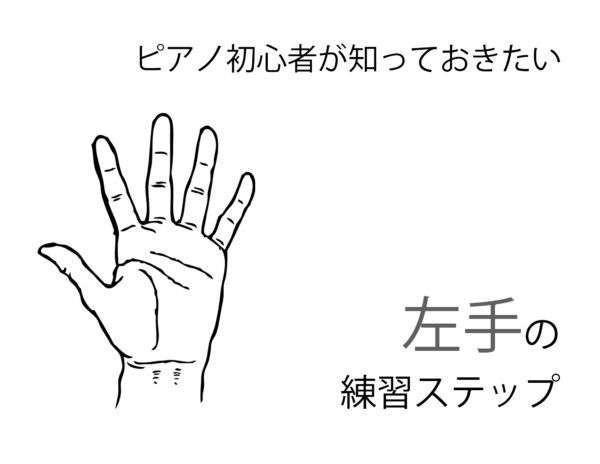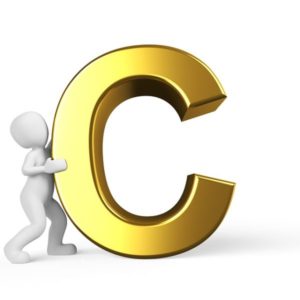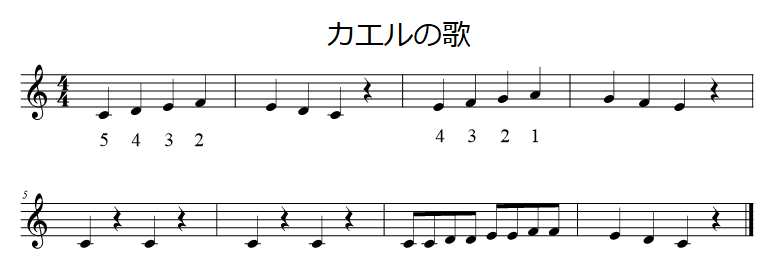
ピアノを始めて、最初に苦労するのが「左手」という人は大勢います。
特に、和音ではなく単音を短い間隔で連続で弾くときに、音の大きさやリズム、レガートと呼ばれる音と音のつながり方などに統一感が出るようにする必要があります。
どうすれば左手で上手くピアノを弾けるのか、何をすれば上達していくのか、私の経験を踏まえて練習方法を順番に説明していきます。
ステップ0 和音

まず最初に和音を正確に弾くことができるようになることが次以降のステップに移る最低条件です。
「そんなの簡単じゃん」と思っているあなた!
意外とできていない人が多いんです。
例えばCのコード(ド・ミ・ソ)を左手で弾くときに、3つの鍵盤を全く同じタイミングで(ドミソ)と弾けていますか?
(ド→ミ→ソ)や(ソ→ミ→ド)などと微妙にズレて打鍵されていないか、音をよく聴いて確認してみてください。
微妙にずれてしまっている人は、指から鍵盤に向かって力が均一に入っていません。
これは練習の問題ではなく、姿勢や指の形が原因で腕を伸ばす場所や指の種類によってバランスが崩れてしまっているのです。
筋肉やの付き方や重心は、左右対称ではありませんので、自分にあった体重のかけ方、力の入れ方をマスターする必要があります。
こちらの記事で姿勢や指の形を再確認してみてください。
ステップ1 リズム

和音がピッタリタイミングよく弾けるようになったら次はリズムです。
リズムが取れるようになると、左手すべての指の筋肉の使い方をマスターする第一歩が終わります。
ピアノはブランクがあると技術が落ちるのですが、特にこのリズムに統一感を持たせて演奏するスキルは、大きく損なわれると思います。
リズムの練習は、ピアノの技術が多少上達したあとも日々の練習のはじめに組み込んでいくことをおすすめします。
まず最初に非常に簡単な曲をしっかりとリズム通りに弾けるようになるまでメトロノームを使って練習しましょう。
今回は「カエルの歌」を例にとって説明します。

カエルの歌のメロディーは上図の楽譜になります。
一部、音符の下に書いた数字は指番号の例です。できるだけすべての指を使うように弾いてみましょう。
なかでも多くの人の場合苦戦するのは筋肉が弱い「小指」です。
そのため、「5」つまり小指を多く使うようにしましょう。
コレを左手で練習します。テンポは![]() (4分音符1つで1秒)で最初に演奏してみましょう。
(4分音符1つで1秒)で最初に演奏してみましょう。
このテンポは実際の曲の速さよりもかなり遅いですよね。
実はこれには理由があります。
最初に遅いテンポから練習するのは、単に弾きやすいだけでなく、どの指が苦戦しているかがハッキリと分かるからです。
![]() ができるようになったら、テンポを早くしていきましょう。あまり細かくテンポを変えていくのも効率が悪いので、個人的には
ができるようになったら、テンポを早くしていきましょう。あまり細かくテンポを変えていくのも効率が悪いので、個人的には![]() と
と ![]() の3段階で十分かと思います。
の3段階で十分かと思います。
ステップ2 大きさ

リズムに合わせて弾くことができるようになってきたら、音の大きさに重点を当てて練習します。
どうしても最初の頃は筋肉の違いから、親指ほど大きな音に、小指ほど小さな音になりがちです。
どの指を使っても関係なく、楽譜の指示通りに音の大きさを自分で調整できるようになるまで練習します。
例として前回同様「カエルの歌」をアレンジして付け加えました。

上記の楽譜の場合、特に第2小節と第3小節は指の筋肉の大きさに逆行して音の大きさを変えます。
この部分は特に自分が引いた音をしっかりと聞きながら、楽譜を再現できているか確認していきましょう。
今回は練習用に適当にアレンジしていますが、自分が考えるカエルの歌のイメージ、情景から思いつく通りに強弱をつけても構いません。
ただし、練習ですのでときには小指で大きな音を出したり、小さな音を出したりできるように楽譜をアレンジしていきましょう。
どの指でどのぐらいの力加減で打鍵すると、どのぐらいの音の大きさが出てくるのか、しっかり身につくまで練習しましょう。
ステップ3 レガート

レガートとは連続する2つの連続する音をなめらかにつないで演奏することです。
スタッカートのまったく逆、楽譜記号でいうと「スラー」と同じことです。
ステップ3まではピアノの「打鍵」が重要となっていました。しかし今回は逆の「離鍵(鍵盤から指を離すこと)」が非常に重要になります。
よくありがちなのは、「次の音を弾くタイミング」を調整してレガードを意識しようとすることがあります。
これも間違っているわけではないのですが、左手の練習で特に気をつけて欲しいのは「音を止めるタイミング」です。
鍵盤から指を離すと、打鍵のときとは逆に、ピアノの音を出すハンマーが元の位置に戻ります。
このハンマーが戻る速度によって、音の伸び方に違いが出ます。
そのため、レガートにする際は離鍵をできるだけ優しくゆっくり行うようにしてください。
電子ピアノはハンマーなどありませんが、特に最近の電子ピアノはこの離鍵の際の音の出し方もアップライトピアノなどと同じようになっていて、その技術も年々上がっています。
電子ピアノでも同じように離鍵を意識するようにしてください。
実はレガートを極めることは左手だけにかかわらず右手に関しても非常に難しい技術です。
「カエルの歌」に限らず、普段からレガート、つまり離鍵を意識して音のつながりをなめらかにするように意識していきましょう。
左手の練習にオススメの楽譜
左手・右手関係なくやはりハノンのパート1は最初の練習に最適です。
コレはもともとフィンガートレーニングをするために作られたもので、ステップ1から4まですべての練習に役に立ちます。
誰でも一度は練習するべき曲になっています。
ハノンに比べたら数段レベルが上がってしまいますが、弾いていて・聞いていて楽しい練習曲です。
様々な練習要素が組み合わさっていて、いい練習になると思います。
また、ここまで弾けるようになると自分の好きな多くの曲が上手く弾けるまで技術が身に付いていることでしょう。
コメントを残す